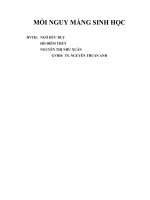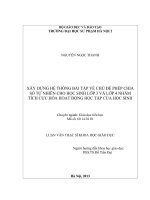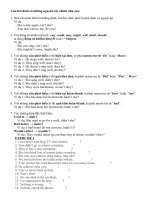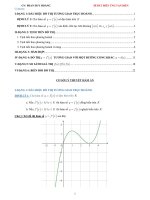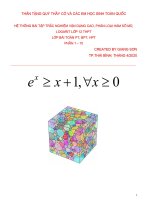Bài tập về chủ đề education môn tiếng anh của cô trang anh | Tiếng Anh, Lớp 12 - Ôn Luyện
Bạn đang xem bản rút gọn của tài liệu. Xem và tải ngay bản đầy đủ của tài liệu tại đây (541.05 KB, 8 trang )
<span class='text_page_counter'>(1)</span><div class='page_container' data-page=1>
<b>CHƯƠNG TRÌNH HỖ TRỢ 2K1,2K2,2K3 </b>
<b>(CHỦ ĐỀ EDUCATION) </b>
<b>Compiled by Mrs Trang Anh </b>
<i><b>Facebook: Mrstranganh87 </b></i>
<b>Read the passage carefully and choose the correct answer. </b>
As Chinese society changes, higher education is undergoing major transformations. The university
model of the United States and other Western countries has a powerful influence. New trends in
Chinese higher education are attracting the attention of global educators. Since the establishment
of Western-oriented modern universities at the end of nineteenth century, Chinese higher
education has continued to evolve. Over the past two decades, however, tremendous economic
development in China has stimulated reforms in higher education that have resulted in some
remarkable changes.
The first modern institution, Peiyang University, was founded in Tianjin. The university changed
its name to Tianjin University in 1951 and became one of the leading universities in China: Next,
Jiaotong University was founded in Shanghai in 1896. In the 1950s, most of this university was
moved to Xi'an, an ancient capital city in northwest China, and became Xi'an Jiaotong University;
the part of the university remaining in Shanghai was renamed Shanghai Jiaotong University.
Tianjin University celebrated its hundredth anniversary in 1995, followed by Xi'an Jiaotong and
Shanghai Jiaotong Universities in 1996. Other leading universities, such as Zhejiang University
(1897), Beijing University (1898), and Nanjing University (1902) also recently celebrated their
hundredth anniversaries, one after another. These celebrations marked the beginning of a new
chapter in Chinese higher education.
1. The text is about _______.
a. Chinese education system
b. some famous universities in China
c. the western influences on Chinese education
d. application for a university in China
2. Chinese higher education _______.
a. is not affected by any others
b. has not really well-developed
c. has developed since the end of nineteenth century
d. is not paid any attention by global educators
3. Chinese higher education _______.
a. has been stable since nineteenth century
b. has decreased over the past two decades
c. has not got any changes
d. has been affected by the country's economic development
4. Tianjin University was founded in _______.
a. 1895 b. 1896 c. 1950 d. 1951
5. Which university celebrated the hundredth anniversaries in 2002?
</div>
<span class='text_page_counter'>(2)</span><div class='page_container' data-page=2>
c. Xi'an Jiaotong University d. Beijing University
<b>Full in each numbered blank with one suitable word or phrase. </b>
Since China adopted its open-door (1) _____ approximately twenty-five years ago, Chinese higher
education has begun once again to draw closer to the (2) _____ Western world. China's (3) _____ to
send scholars and students to the United States at the end of the 1970s, after thirty years of
hostility between the two countries, marked a dramatic turning (4) _____ in the nation's educational
history. Today, about 50,000 Chinese students, are studying in the United States, accounting (5)
_____ 10 percent of the total international students in the country. More and (6) _____ Chinese
students have gone to other countries to study. According to statistics from the United Nations
Educational, Scientific, and Cultural Organization (UNESCO), China (7) _____ more students than
any other country to study abroad. In the other direction, many students from the United States
and (8) _____ are going to China to study language, culture, history, traditional Chinese medicine,
science, engineering, and other (9) ______. The increasing number of international students
worldwide demonstrates a relatively quick change in the (10) _____ of global education.
6. a. way b. law c. rule d. policy
7. a. progress b. advanced c. head d. reach
8. a. decide b. decisive c. decision d. decider
9. a. point b. spot c. top d. stain
10. a. for b. to c. up d. over
11. a. as b. more c. than d. much
12. a. regards b. mails c. posts d. sends
13. a. elsewhere b. wherever c. where d. whereas
14. a. matters b. things c. fields d. items
15. a. interfere b. integration c. exchange d. mixture
<b>Read the passage carefully and choose the correct answer. </b>
University Entrance Examination is very important in Vietnamese students. High school graduates
have to take it and get high results to be admitted to universities. The pressure on the candidates
remains very high despite the measures that have been taken to reduce the heat around these
exams, since securing a place in a state university is considered a major step towards a successful
<i><b>career for young people, especially those from rural areas or disadvantaged families. In the year </b></i>
2004, it was estimated that nearly 1 million Vietnamese students took the University Entrance
Examination, but on average only 1 out of 5 candidates succeeded. Normally, candidates take 3
exam subjects, and each lasts; 180 minutes for the fixed group of subjects they choose. There are 4
fixed groups of subjects: Group A: Mathematics, Physics, and Chemistry; Group B: Mathematics,
Biology, and Chemistry; Group C: Literature, History, and Geography; Group D: Literature, Foreign
Language, and Mathematics.
In addition to universities, there are community colleges, art and technology institutes;
professional secondary schools, and vocational schools which offer degrees or certificates from
a-few-month to 2-year courses.
According to Vietnam's Ministry of Education and Training, there are currently 23 non-public
universities, accounting for 11% of the total number of universities. These non-public universities
are currently training 119,464 students, or 11.7% of the total number of students. The government
is planning to increase the number of non-public universities to 30% by 2007.
1. University Entrance Examination in Vietnamese is very _______.
a. interesting b. stressful c. free d. easy
<i>2.The word those refers to _______. </i>
</div>
<span class='text_page_counter'>(3)</span><div class='page_container' data-page=3>
3. In 2004, the proportion of the students who got success in University Entrance Examination was
about _______ percent.
a. 5 b. 10 c. 20 d. 50
4.Which sentence refers to the University Entrance Examination in Vietnam?
a. Students find it easy to get success in the University Entrance Examination.
b. Math is compulsory in the University Entrance Examination.
c. Students are not allowed to choose their exam subjects.
d. There are four fixed groups of exam subjects for students to choose.
5. According to the passage, _______.
a. the Vietnamese government will close all non-public universities by next year.
b. the Vietnamese government does not appreciate non-public universities
c. the Vietnamese government encourages the establishing of non-public universities.
d. Vietnamese students have no alternative to continue their higher study besides universities.
<b>Fill in each numbered blank with one suitable word or phrase. </b>
The University of Oxford, informally called "Oxford University", or simply
"Oxford", (1) ______ in the city of Oxford, in England, is (2) ______ oldest university in the
English-speaking world. It is also considered as one of the world's leading (3) ______ institutions.
The university traces, its roots back to at least the end of the 11th century, (4) ______ the exact date
of foundation remains unclear. Academically, Oxford is consistently ranked in the world's top ten
universities. The University is also open (5) ______ overseas students, primarily from American
universities, who may (6) _____ in study abroad programs during the summer months for more
than a century, it has served as the home of the Rhodes Scholarship, (7) ______ brings highly
accomplished students from a number of countries to study at Oxford as (8) ______ The University
of Oxford is also a place where many talented leaders from all over the world used to study.
Twenty-five British Prime Ministers attended Oxford, including Margaret Thatcher and Tony Blair.
At (9) ______ 25 other international leaders have been educated at Oxford, and this number includes
King Harald V of Norway and King Abdullah II of Jordan. Bill Clinton is the first American President
to attend Oxford. Forty-seven Nobel (10) __ winners have studied or taught at Oxford.
1. a. put b. placed c. located d. stood
2. a. a b. an c. the d. Ø
3. a. learning b. academic c. graduating d. scholar
4. a. although b. because c. since d. if
5. a. to b. for c. from d. up
6. a. write b. name c. enroll d. require
7. a. that b. where c. whose d. which
8. a. postgraduates b. postgraduated c. postgraduation d. postgraduating
9. a. last b. least c. late d. lately
10.a. present b. gift c. medal d. prize
<b>Read the passage carefully and choose the correct answer. </b>
According to the Academic Ranking of World Universities, more than 30 of the highest-ranked 45
institutions are in the United States, as measured by awards and research output. Public
universities, private universities, liberal arts colleges, and community colleges all have a significant
role in higher education in the United States. An even stronger pattern is shown by the
Webometrics Ranking of World Universities with 103 US universities in the World's Top 200
universities.
</div>
<span class='text_page_counter'>(4)</span><div class='page_container' data-page=4>
associate's degree, 17.1 percent held a bachelor's degree, and 9.9 percent held a graduate or
professional degree.
Educational attainment in the United States is similar to that of other developed countries. Colleges
and universities in the U.S. vary in terms of goals: some may emphasize a vocational, business,
engineering, or technical curriculum while others may emphasize a liberal arts curriculum. Many
combine some or all of the above.
Students can apply to some colleges using the Common Application. There is no limit to the
number of colleges or universities to which a student may apply, though an application must be
submitted for each.'
Graduate study, conducted after obtaining an initial degree and sometimes after several years of
professional work, leads to a more advanced degree such as a master's degree. After additional
years of study and sometimes in conjunction with the completion of a master's degree, students
may earn a Doctor of Philosophy (Ph.d.) or other doctoral degree.
Only 8.9 percent of US students ever receive postgraduate degrees, and most, after obtaining their
bachelor's degree, proceed directly into the workforce.
1. Not any other country has more highest-ranked universities and institutions than the US does.
a. True b. False c. No information
2. Higher education in the USA is the same as that in the China.
a. True b. False c. No information
3. Each student can apply only one college or university.
a. True b. False c. No information
4. Students can continue studying to get a more advanced degree after working for some years.
a. True b. False c. No information
5. After getting their bachelor's degree, most of US students continue their studies.
a. True b. False c. No information
<b>Fill in each numbered blank with one suitable word or phrase. </b>
Here's some advice for trying to find the university that works for you.
You need to examine (1) _____ and your reasons for going to university before you start your
search. Why are you going? What are your abilities and strengths? What are your weaknesses?
What do you want out of life? Are you socially self-sufficient (2) _____ do you need warm, familial
(3) _____? Talk with your family, friends and high-school counselors as you ask these questions. The
people (4) _____ know you best can help you the most with these important issues.
Very few high-school students have enough information or (5) _____ to choose a major. You need to
be well (6) _____ to determine your interest and aptitude. Many students (7) _____ their minds two
or three times before they settle on a major.
If you do not have to go to university right (8) _____ it is never too late. There is no such thing as the
perfect time to start university. Some students benefit from a year off to work, study or travel, and
these experiences (9) _____ them to be better, more engaged students. Some students choose to
apply to university and gain admission and then defer their entrance, while others wait to apply
until after they have had (10) _____ alternative experience.
1. a. you b. your c. yours d. yourself
2.a. or b. but c. nor d. either
3.a. support b. bringing c. feeding d. growth
4.a. which b. whom c. who d. whose
5.a. expenditure b. experience c. experiment d. expert
6.a. prepare b. prepared c. preparation d. preparative
</div>
<span class='text_page_counter'>(5)</span><div class='page_container' data-page=5>
8.a. for b. up c. over d. away
9.a. allow b. make c. let d. advise
10a. a b. an c. the d. Ø
<b>Read the passage carefully and choose the correct answer. </b>
The American education system requires that students complete 12 years of primary and
secondary education prior to attending university or college. This may be accomplished either at
<i><b>public or government-operated schools, or at private schools. These 12 years of schooling or their </b></i>
equivalent may also be completed outside the USA, thus giving foreign students the opportunity to
pursue the benefits of the American education system and obtain a quality American education.
Perhaps one of the most impressive facts is that a large number of presidents, prime ministers and
leaders from other countries have experienced the American education system and graduated
from a university or school in the USA. In many fields and industries, the American education
system offers the most cutting-edge, sought-after programs at the world's best schools. That is
why graduating from an accredited American school and being exposed to the rigors of the
American education system is an investment in your future.
Whether you want to study at a top USA university, a top USA college, a vocational or high school, a
thorough understanding of how the American education system works is essential. Without a clear
grasp of the American education system, an international student will find it difficult to make the
right academic choices. It is no surprise that the American education system and the American
school system host more international students than any other country in the world!
<i>1. The expression government-operated could best be replaced by _____. </i>
a. independent b. state c. vocational d. boarding
2. According to the text, students in the USA _______.
a. are made to take primary and secondary education in the country
b. are not necessarily take primary and secondary education in the country
c. spend less than 12 years for primary and secondary education
d. needn't take primary and secondary education
3.The writer _______ the US education.
a. appreciates b. underestimates c. overstates d. dislikes
4.Which is true?
a. The US education is not good enough for foreign students.
b.. Foreign students are not offered opportunities in the US:
c. There are not many foreign students in the US.
d. Many leaders all over the world have studied in the US.
5.What is the writer's advice?
a. International students should not invest their future education in the US.
b. International students should not study at a top USA university, a top USA college, a vocational
or high school.
c. Without a clear grasp of the American education system, an international student can make the
right academic choices
d. International students should have a thorough understanding of how the American education
system works before going there to study.
<b>Fill in each numbered blank with one suitable word or phrase. </b>
</div>
<span class='text_page_counter'>(6)</span><div class='page_container' data-page=6>
Primary school (6) _____ of 8 groups, thus schooling (7) _____ for 8 years. During the first two years,
which (8) _____ kindergarten, children receive an average of 22 hours of (9) _____, during the last 6
years children receive an average of 25 hours per week. Schools are open 5 days a week, but
children are free on Wednesday afternoon. At the end of primary school, or in group 8, schools
advice on secondary school choice. Most schools use a national test to support this advice, for
instance the 'Citotoets’, a test (10) ____ by the Central Institute for Test development.
1. a. a b. an c. the d. Ø
<b>2. </b>a. afford b. enter c. come d. run
<b>3. </b>a. although b. despite c. in spite d. due to
<b>4. </b>a. of b. on c. in d. for
<b>5. </b>a. old b. elderly c. aging d. age
<b>6. </b>a. includes b. contains c. consists d. composes
<b>7. </b>a. spends b. lasts c. lengthens d. takes
<b>8. </b>a. also called b. is also called c. is called also d. is also calling
<b>9. </b>a. educate b. educative c. educator d. education
<b>10. </b> a. develop b. to develop c. developed d. developing
<b>Choose the item (A, B, C or D) that best completes each of the following sentences. </b>
In 1988, for the first time in British history, a National Curriculum was introduced. The National
Curriculum tells pupils which subjects they have to study, what they must learn and when they
have to take assessment tests. [assessment: đánh giá]
Between the ages of 14 and 16, pupils study for their GCSE (General Certificate of Secondary
Education) exams. Pupils must take English Language, Maths and Science for GCSE, as well as a half
GCSE in a foreign language and Technology. In addition, they must also be taught Physical
Education, Religious Education and Sex Education, although they do not take exams in these
subjects.
At the age of 16, pupils can leave school. If pupils stay on, they usually take A (Advanced) levels, AS
(Advanced Supplementary) level or GNVQs (Greater National Vocational Qualifications). It is quite
common to combine, for example, two A levels with one AS level, or one A level with one GNVQ.
Pupils taking A levels study traditional subjects, such as French, Physics or History. To go to
university, pupils usually need two or three A levels.
AS levels are the same standard as A levels, but only half of the content: AS level German pupils
take the A-level German language exam, but do not take the A-level German Literature exam.
GNVQs are vocational qualifications. Pupils usually take on GNVQ in subjects such as Business,
Leisure and Tourism, Manufacturing, and Art and Design. One GVNQ (at advanced level) is equal to
two A levels.
1. Britain began to have a National Curriculum _________.
A. one hundred years ago B. in the nineteenth century
C. in 1898 D. in 1988
2. Which of the following subjects do British students NOT take exams in?
A. Science B. Physical Education
C. Maths D. English Language
3. Pupils need_________A levels to continue to study at university.
A. one or two B. two or three
C. four or five D. five or six
4. Which of the following subjects do pupils NOT take on GNVQ in?
A. German Literature B. Business
</div>
<span class='text_page_counter'>(7)</span><div class='page_container' data-page=7>
5. Pupils normally study for their GCSE between the ages of _________.
A. 12 and 14 B. 14 and 16
C. 15 and 17 D. 16 and 18
<b>Choose the word or phrase that best fits each space in the following passage. </b>
A tiny village school is soon to celebrate its 110 birthday - against all expectations. Five years ago it
seemed certain to close but parents and other villagers fought the local education authority and
raised funds to keep it (46)_________. It is now ending its first term as a school (47)_________by the
<b>village community and the villagers are just proud of their achievement. </b>
They were furious when education chiefs tried to make them send the village children to other
schools further away because the number of pupils at the village school was too (48)_________. The
villagers started a huge campaign to (49)_________money. They collected enough to hire a teacher
and begin to help with school cleaning, lunch supervision and lessons. Now the school is doing well
<b>and it seems (50)________it will continue to run in the future. </b>
1. A. open B. opened C. to opening D. for opening
2. A. run B. running C. has run D. to run
3. A. little B. less C. few D. small
4. A. rise B. raise C. pay D. deal
5. A. in case B. even though C. as if D. if only
<b>Choose the option (A, B, C or D) that best completes each of the following sentences. </b>
Last week I went to visit Atlantic College, an excellent private college in Wales. Unusually, it gives
people much needed experience of life outside the classroom, as well as the opportunity to study
for their exams. The students, who are aged between 16 and 18 and come from all over the word,
spend the morning studying. In the afternoon they go out and do a really useful activity, such as
helping on the farm, looking after people with learning difficulties, or checking for pollution in
rivers.
One of the great things about Atlantic College students is that they come from many different social
backgrounds and countries. As few can afford the fees of £20,000 over two years, grants are
available.
A quarter of students are British, and many of those can only attend because they receive
government help.
“I really admire the college for trying to encourage international understanding among young
people", as Barbara Molenkamp, a student from the Netherlands, said. ''You learn to live with
people and respect them, even the ones you don't like. During the summer holidays my mother
<i><b>couldn't believe how much less I argued with my sister." </b></i>
To sum up, Atlantic College gives its students an excellent education, using methods which really
seem to work.
1. What is the writer trying to do in the text?
A. give an opinion about a particular student
B. give an opinion about a special type of education
C. describe the activities the students do in their free time
D. describe his own experience of education
2. What can a reader find out from this text?
A. how to become a student at Atlantic College
B. what kind of programme Atlantic College offers
C. what the British education system is like
</div>
<span class='text_page_counter'>(8)</span><div class='page_container' data-page=8>
A. It doesn't allow students enough study time.
B. Its students are taught to like each other.
C. It doesn’t give good value for money.
D. Its way of teaching is successful.
4. How has Barbara changed since being at Atlantic College?
A. She knows a lot about other countries.
B. She is more confident than her sister now.
C. She finds it easier to get on with other people.
D. She prefers her new friends to her family.
<i><b>5. The word "argued" in the third paragraph is closest in meaning to_________. </b></i>
A. quarreled B. respected C. admired D. regarded
<b>Choose the word or phrase (A, B, C, or D) that best fits each space in the following passage. </b>
The relationship between students and teachers is (1)_________formal in the USA than in many other
countries, especially at the college level. American college students do not stand up when their
teacher enters the room. Students are generally encouraged to ask questions in class, to stop in the
professor's of lice for extra help, and to phone if they are absent and need a(n) (2)_________. Most
teachers allow students to enter class late or leave early, if necessary. Despite the lack of formality,
students are still expected to be polite to their teacher and fellow classmates. When students want
to ask questions, they usually (3)__________a hand and wait to be called on. When the teacher or a
student is speaking to the class, it is rude to begin whispering (4)_________another classmate. When
a test is being given, talking to' a classmate is not only rude but also risky. Most American teachers
consider that students who are talking to each other (5) _________a test are cheating.
1. A. much B. most C. a little D. less
2. A. assignment B. homework C. information D. housework
3. A. raise B. hold C. hang D. rise
</div>
<!--links-->


